Abstract
The role of cell-mediated immunity against infection with Treponema pallidum subsp. pertenue in humans or experimental animals is unclear. Hamsters injected subcutaneously in the hind paws with 4 x 10(6) unfractionated lymph node cells or enriched lymph node T cells (immunoglobulin negative, Ia negative) from T. pallidum subsp. pertenue-immune hamsters were resistant to challenge with T. pallidum subsp. pertenue. The popliteal lymph nodes of hamsters that received immune cells weighed less and had significantly fewer treponemes than did lymph nodes from hamsters infused with cells from nonimmune donors. Furthermore, recipients of immune T cells failed to develop antitreponemal antibodies 21 days after challenge. Enriched T cells were obtained by flow cytometric separation by using monoclonal anti-Ia antibody 14-4-4s, which identified hamster B cells. Flow cytometric analysis by two-color immunofluorescent staining with anti-hamster-immunoglobulin and monoclonal anti-Ia antibody 14-4-4s confirmed that monoclonal anti-Ia antibody 14-4-4s recognized B cells. In addition, lymph node cells obtained after treatment with anti-Ia monoclonal antibody 14-4-4s and complement were 97% T cells, as determined by monoclonal antibody 20, a hamster T-cell marker. These results demonstrated that highly enriched T cells (immunoglobulin negative, Ia negative) from T. pallidum subsp. pertenue-immune hamsters conferred partial protection on hamsters against infection with T. pallidum subsp. pertenue.
Full text
PDF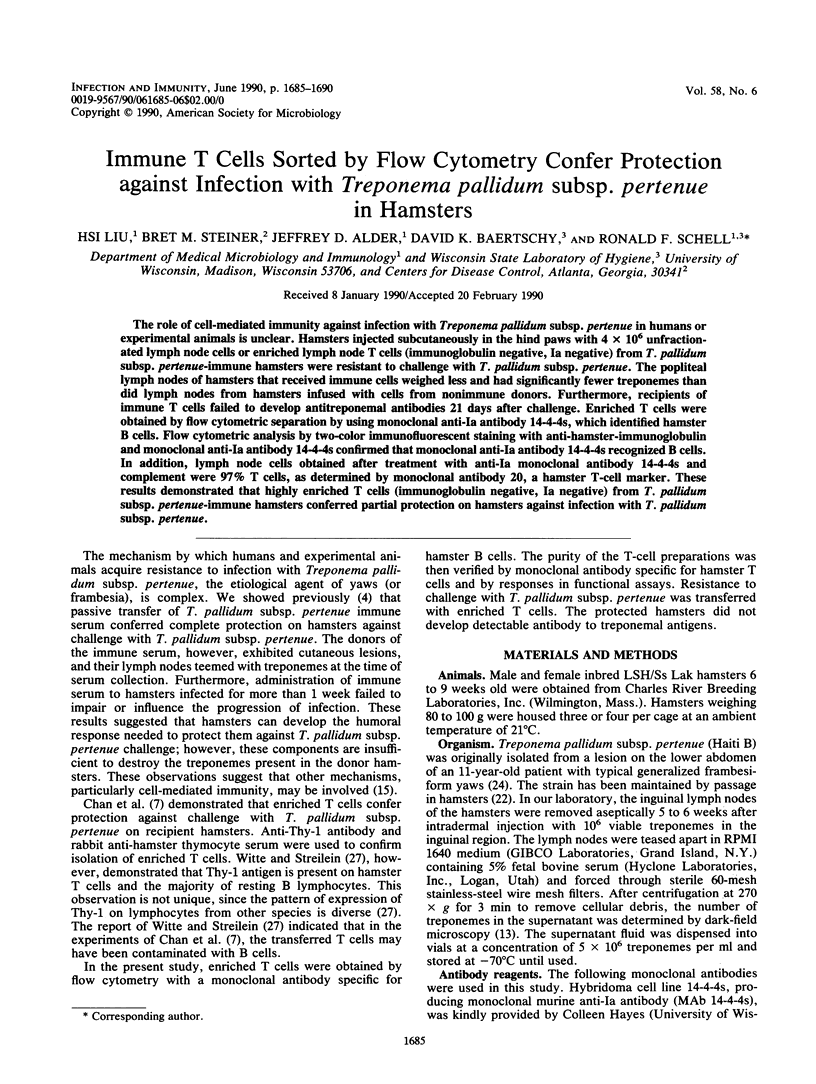
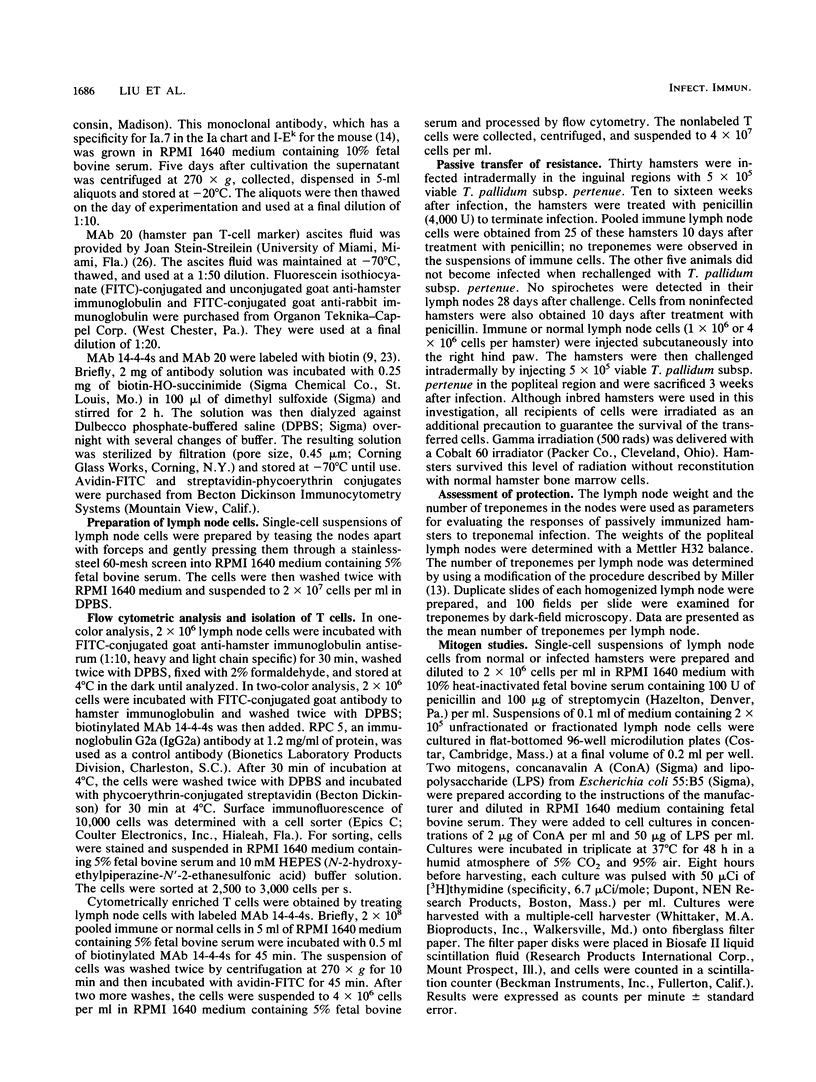
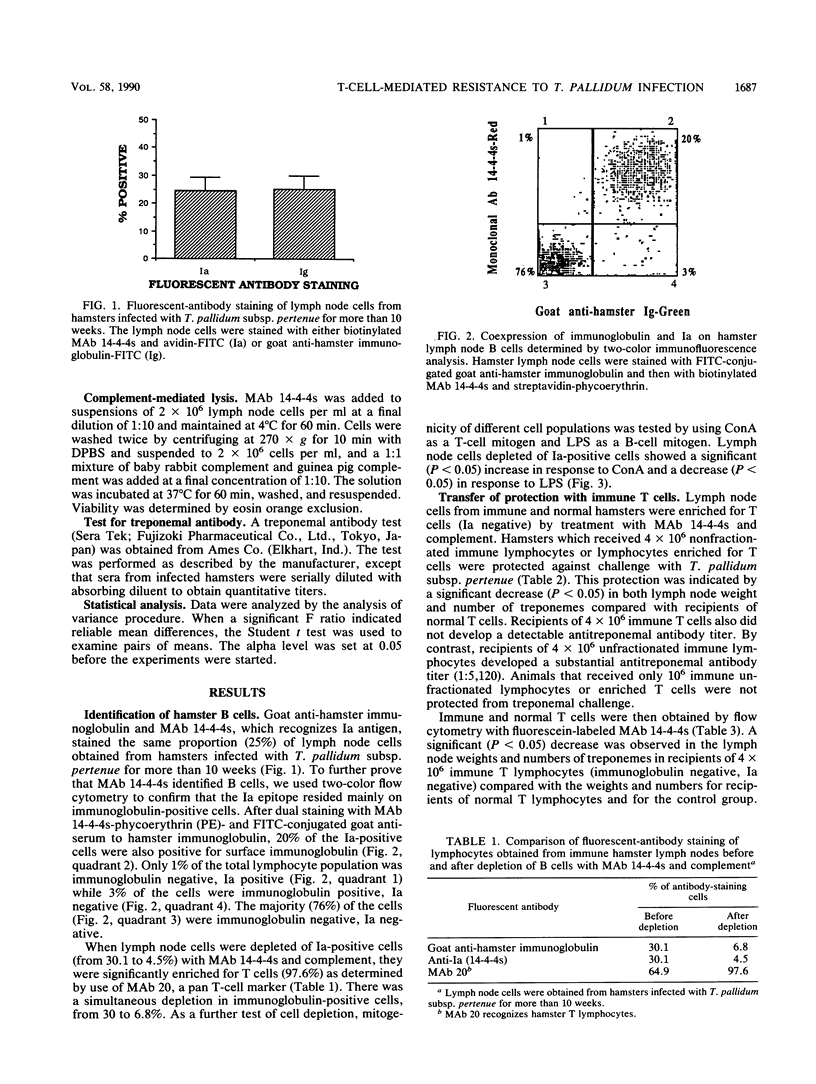
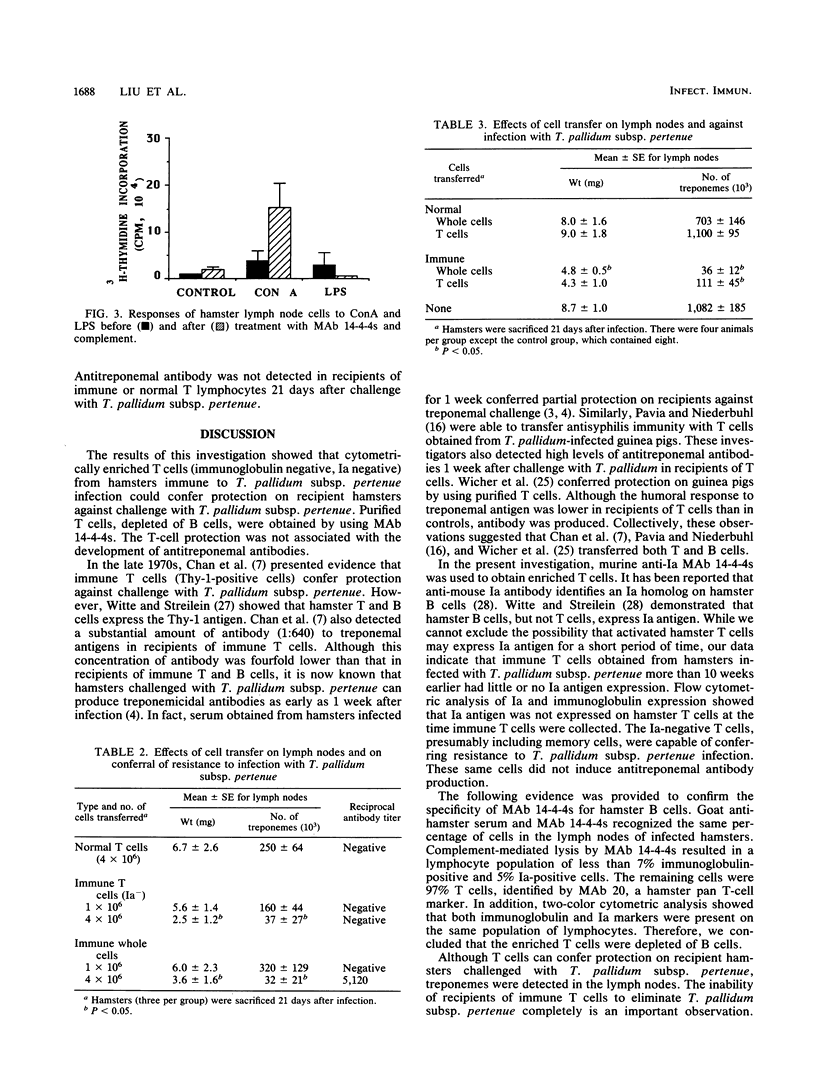
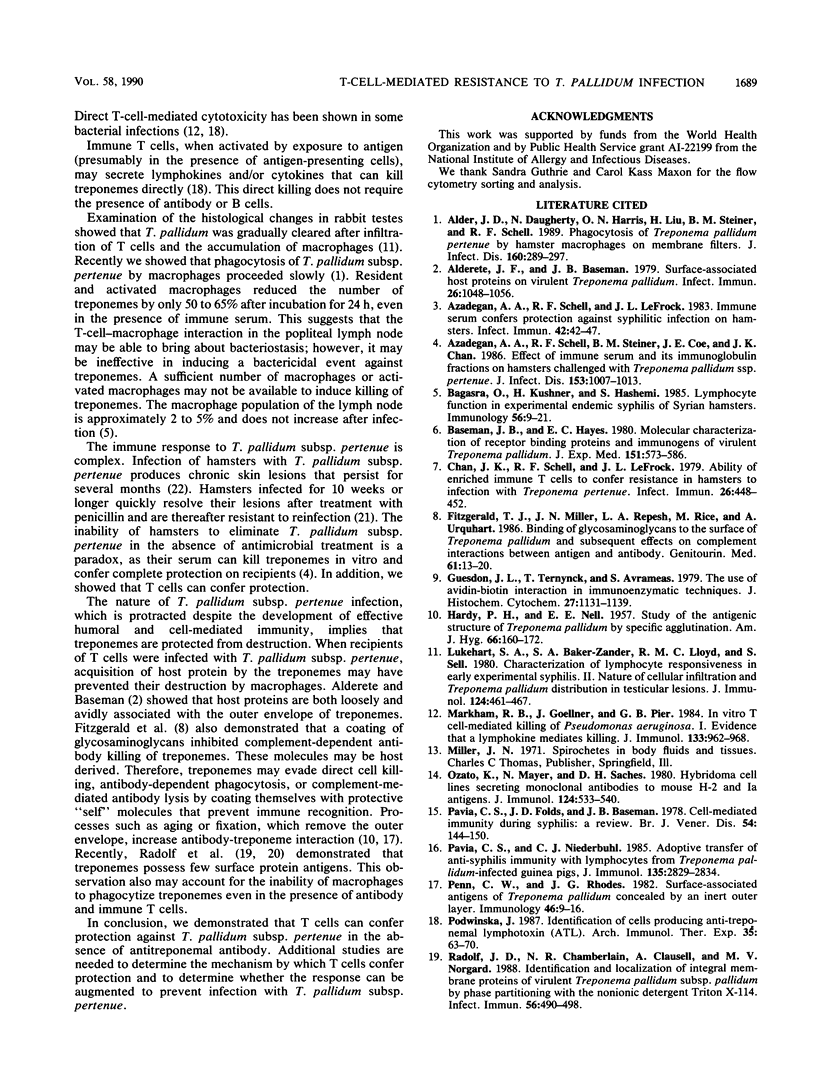
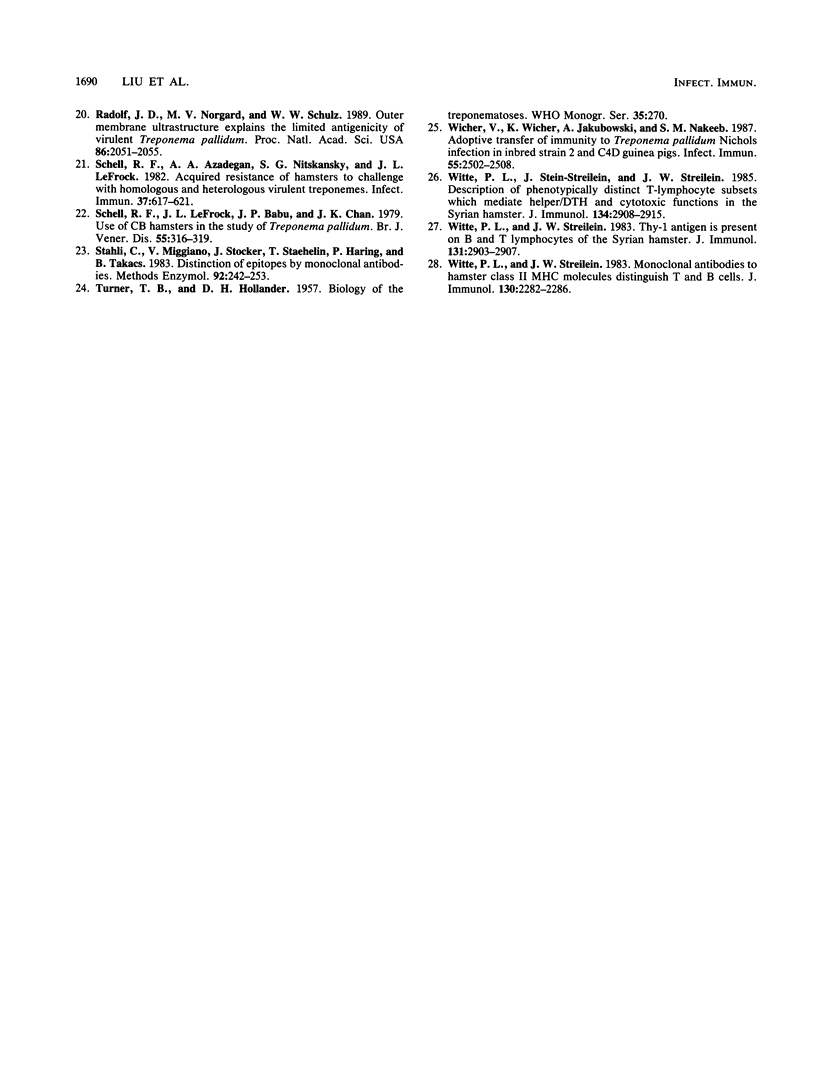
Selected References
These references are in PubMed. This may not be the complete list of references from this article.
- Alder J. D., Daugherty N., Harris O. N., Liu H., Steiner B. M., Schell R. F. Phagocytosis of Treponema pallidum pertenue by hamster macrophages on membrane filters. J Infect Dis. 1989 Aug;160(2):289–297. doi: 10.1093/infdis/160.2.289. [DOI] [PubMed] [Google Scholar]
- Alderete J. F., Baseman J. B. Surface-associated host proteins on virulent Treponema pallidum. Infect Immun. 1979 Dec;26(3):1048–1056. doi: 10.1128/iai.26.3.1048-1056.1979. [DOI] [PMC free article] [PubMed] [Google Scholar]
- Azadegan A. A., Schell R. F., LeFrock J. L. Immune serum confers protection against syphilitic infection on hamsters. Infect Immun. 1983 Oct;42(1):42–47. doi: 10.1128/iai.42.1.42-47.1983. [DOI] [PMC free article] [PubMed] [Google Scholar]
- Azadegan A. A., Schell R. F., Steiner B. M., Coe J. E., Chan J. K. Effect of immune serum and its immunoglobulin fractions on hamsters challenged with Treponema pallidum ssp. pertenue. J Infect Dis. 1986 Jun;153(6):1007–1013. doi: 10.1093/infdis/153.6.1007. [DOI] [PubMed] [Google Scholar]
- Bagasra O., Kushner H., Hashemi S. Lymphocyte function in experimental endemic syphilis of Syrian hamsters. Immunology. 1985 Sep;56(1):9–21. [PMC free article] [PubMed] [Google Scholar]
- Baseman J. B., Hayes E. C. Molecular characterization of receptor binding proteins and immunogens of virulent Treponema pallidum. J Exp Med. 1980 Mar 1;151(3):573–586. doi: 10.1084/jem.151.3.573. [DOI] [PMC free article] [PubMed] [Google Scholar]
- Chan J. K., Schell R. F., LeFrock J. L. Ability of enriched immune T cells to confer resistance in hamsters to infection with Treponema pertenue. Infect Immun. 1979 Nov;26(2):448–452. doi: 10.1128/iai.26.2.448-452.1979. [DOI] [PMC free article] [PubMed] [Google Scholar]
- Fitzgerald T. J., Miller J. N., Repesh L. A., Rice M., Urquhart A. Binding of glycosaminoglycans to the surface of Treponema pallidum and subsequent effects on complement interactions between antigen and antibody. Genitourin Med. 1985 Feb;61(1):13–20. doi: 10.1136/sti.61.1.13. [DOI] [PMC free article] [PubMed] [Google Scholar]
- Guesdon J. L., Ternynck T., Avrameas S. The use of avidin-biotin interaction in immunoenzymatic techniques. J Histochem Cytochem. 1979 Aug;27(8):1131–1139. doi: 10.1177/27.8.90074. [DOI] [PubMed] [Google Scholar]
- HARDY P. H., Jr, NELL E. E. Study of the antigenic structure of Treponema pallidum by specific agglutination. Am J Hyg. 1957 Sep;66(2):160–172. doi: 10.1093/oxfordjournals.aje.a119893. [DOI] [PubMed] [Google Scholar]
- Lukehart S. A., Baker-Zander S. A., Lloyd R. M., Sell S. Characterization of lymphocyte responsiveness in early experimental syphilis. II. Nature of cellular infiltration and Treponema pallidum distribution in testicular lesions. J Immunol. 1980 Jan;124(1):461–467. [PubMed] [Google Scholar]
- Markham R. B., Goellner J., Pier G. B. In vitro T cell-mediated killing of Pseudomonas aeruginosa. I. Evidence that a lymphokine mediates killing. J Immunol. 1984 Aug;133(2):962–968. [PubMed] [Google Scholar]
- Ozato K., Mayer N., Sachs D. H. Hybridoma cell lines secreting monoclonal antibodies to mouse H-2 and Ia antigens. J Immunol. 1980 Feb;124(2):533–540. [PubMed] [Google Scholar]
- Pavia C. S., Niederbuhl C. J. Adoptive transfer of anti-syphilis immunity with lymphocytes from Treponema pallidum-infected guinea pigs. J Immunol. 1985 Oct;135(4):2829–2834. [PubMed] [Google Scholar]
- Pavis C. S., Folds J. D., Baseman J. B. Cell-mediated immunity during syphilis. Br J Vener Dis. 1978 Jun;54(3):144–150. doi: 10.1136/sti.54.3.144. [DOI] [PMC free article] [PubMed] [Google Scholar]
- Penn C. W., Rhodes J. G. Surface-associated antigens of Treponema pallidum concealed by an inert outer layer. Immunology. 1982 May;46(1):9–16. [PMC free article] [PubMed] [Google Scholar]
- Podwińska J. Identification of cells producing anti-treponemal lymphotoxin (ATL). Arch Immunol Ther Exp (Warsz) 1987;35(1):63–70. [PubMed] [Google Scholar]
- Radolf J. D., Chamberlain N. R., Clausell A., Norgard M. V. Identification and localization of integral membrane proteins of virulent Treponema pallidum subsp. pallidum by phase partitioning with the nonionic detergent triton X-114. Infect Immun. 1988 Feb;56(2):490–498. doi: 10.1128/iai.56.2.490-498.1988. [DOI] [PMC free article] [PubMed] [Google Scholar]
- Radolf J. D., Norgard M. V., Schulz W. W. Outer membrane ultrastructure explains the limited antigenicity of virulent Treponema pallidum. Proc Natl Acad Sci U S A. 1989 Mar;86(6):2051–2055. doi: 10.1073/pnas.86.6.2051. [DOI] [PMC free article] [PubMed] [Google Scholar]
- Schell R. F., Azadegan A. A., Nitskansky S. G., LeFrock J. L. Acquired resistance of hamsters to challenge with homologous and heterologous virulent treponemes. Infect Immun. 1982 Aug;37(2):617–621. doi: 10.1128/iai.37.2.617-621.1982. [DOI] [PMC free article] [PubMed] [Google Scholar]
- Schell R. F., Le Frock J. L., Babu J. P., Chan J. K. Use of CB hamsters in the study of Treponema pertenue. Br J Vener Dis. 1979 Oct;55(5):316–319. doi: 10.1136/sti.55.5.316. [DOI] [PMC free article] [PubMed] [Google Scholar]
- Stähli C., Miggiano V., Stocker J., Staehelin T., Häring P., Takács B. Distinction of epitopes by monoclonal antibodies. Methods Enzymol. 1983;92:242–253. doi: 10.1016/0076-6879(83)92023-2. [DOI] [PubMed] [Google Scholar]
- Wicher V., Wicher K., Jakubowski A., Nakeeb S. M. Adoptive transfer of immunity to Treponema pallidum Nichols infection in inbred strain 2 and C4D guinea pigs. Infect Immun. 1987 Oct;55(10):2502–2508. doi: 10.1128/iai.55.10.2502-2508.1987. [DOI] [PMC free article] [PubMed] [Google Scholar]
- Witte P. L., Stein-Streilein J., Streilein J. W. Description of phenotypically distinct T-lymphocyte subsets which mediate helper/DTH and cytotoxic functions in the Syrian hamster. J Immunol. 1985 May;134(5):2908–2915. [PubMed] [Google Scholar]
- Witte P. L., Streilein J. W. Monoclonal antibodies to hamster class II MHC molecules distinguish T and B cells. J Immunol. 1983 May;130(5):2282–2286. [PubMed] [Google Scholar]
- Witte P. L., Streilein J. W. Thy-1 antigen is present on B and T lymphocytes of the Syrian hamster. J Immunol. 1983 Dec;131(6):2903–2907. [PubMed] [Google Scholar]


